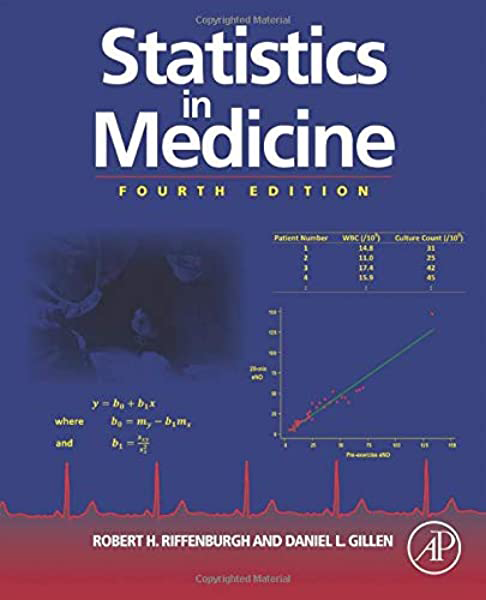Statistics in Medicine, Fourth Edition, by Robert H. Riffenburgh and Daniel L. Gillen, is an excellent book, useful as a reference for researchers in the medical sciences and as a textbook. It focuses largely on understanding statistical concepts rather than on mathematical and theoretical underpinnings. The authors cover both introductory statistical techniques and advanced methods commonly appearing in medical journals.
The text begins with a discussion related to planning studies and writing articles to report results. Following this, it introduces statistics that would typically be covered in an introductory biostatistics course. These include summary statistics, distributions, two-way tables, confidence intervals, and hypothesis tests. In addition, the authors give an overview of a variety of more sophisticated statistical techniques such as regression models for binary and count outcomes, survival analysis, equivalence testing, Bayesian analysis, and meta-analysis.
Stages of Scientific Investigation
Science Underlying Clinical Decision-Making
Why Do We Need Statistics?
Concepts in Study Design
Study Types
Convergence with Sample Size
Sampling Schemes in Observational Studies
Sampling Bias
Randomizing a Sample
How to Plan and Conduct a Study
Mechanisms to Improve Your Study Plan
Reading Medical Articles
Where Articles May Fall Short
Writing Medical Articles
Statistical Ethics in Medical Studies
Conclusion
Notation (or Symbols)
Quantification and Accuracy
Data Types
Multivariable Concepts and Types of Adjustment Variables
How to Manage Data
Defining the Scientific Goal: Description, Association Testing, Prediction
Reporting Statistical Results
A First-Step Guide to Descriptive Statistics
An Overview of Association Testing
A Brief Discussion of Prediction Modeling
Probability and Relative Frequency
Graphing Relative Frequency
Continuous Random Variables
Frequency Distributions for Continuous Variables
Probability Estimates From Continuous Distributions
Probability as Area Under the Curve
Greek Versus Roman Letters
What Is Typical
The Spread About the Typical
The Shape
Sampling Distribution of a Variable Versus a Statistic
Statistical Inference
Distributions Commonly Used in Statistics
Approximate Distribution of the Mean (Central Limit Theorem)
Approximate Distribution of a Sample Quantile
Numerical Descriptors, One Variable
Numerical Descriptors, Two Variables
Numerical Descriptors, Three Variables
Graphical Descriptors, One Variable
Graphical Descriptors, Two Variables
Graphical Descriptors, Three Variables
Principles of Informative Descriptive Tables and Figures
The Normal Distribution
The t Distribution
The Chi-Square Distribution
The F Distribution
The Binomial Distribution
The Poisson Distribution
Error Probabilities
Two Policies of Testing
Distinguishing Between Statistical and Clinical Significance
Controversies Regarding the Rigid Use and Abuse of p-Values
Avoiding Multiplicity Bias
Organizing Data for Inference
Evolving a Way to Answer Your Data Question
Tolerance Intervals for Patient Measurements
Concept of a Confidence Interval for a Parameter
Confidence Interval for a Population Mean, Known Standard Deviation
Confidence Interval for a Population Mean, Estimated Standard Deviation
Confidence Interval for a Population Proportion
Confidence Interval for a Population Median
Confidence Interval for a Population Variance or Standard Deviation
Confidence Interval for a Population Correlation Coefficient
Tests on Categorical Data: 2 × 2 Tables
The Chi-Square Test of Contingency
Fisher’s Exact Test of Contingency
Tests on r × c Contingency Tables
Tests on Proportion
Tests of Rare Events (Proportions Close to Zero)
McNemar’s Test: Matched Pair Test of a 2 × 2 Table
Cochran’s Q: Matched Pair Test of a 2 × r Table
Three or More Ranked Samples With Two Outcome Categories: Royston’s Ptrend Test
Inference for the Risk Ratio: The Log Risk Ratio Test
Inference for the Odds Ratio: The Log Odds Ratio Test
Receiver Operation Characteristic Curves
Comparing Two Receiver Operating Characteristic Curves
Single or Paired Means: One-Sample Normal (z) and t Tests
Two Means Two-Sample Normal (z) and t Tests
Three or More Means: One-Factor Analysis of Variance
Three or More Means in Rank Order: Analysis of Variance Trend Test
The Basics of Nonparametric Tests
Single or Paired Sample Distribution(s): The Signed-Rank Test
Two Independent Sample Distributions: The Rank-Sum Test
Large Sample-Ranked Outcomes
Three or More Independent Sample Distributions: The Kruskal—Wallis Test
Three or More Matched Sample Distributions: The Friedman Test
Three or More Ranked Independent Samples With Ranked Outcomes: Cusick’s Nptrend Test
Three or More Ranked Matched Samples With Ranked Outcomes: Page’s L Test
Potential Drawbacks to Using Nonparametric Tests
Basics Underlying Equivalence Testing
Choosing a Noninferiority or Equivalence Margin
Methods for Noninferiority Testing
Methods for Equivalence Testing
Joint Difference and Equivalence Testing
Testing Variability on a Single Sample
Testing Variability Between Two Samples
Testing Variability Among Three or More Samples
Basics on Tests of Distributions
Test of Normality of a Distribution
Test of Equality of Two Distributions
Contingency as Association
Correlation as Association
Contingency as Agreement
Correlation as Agreement
Agreement Among Ratings: Kappa
Agreement Among Multiple Rankers
Reliability
Intraclass Correlation
Regression Concepts and Assumptions
Simple Regression
Assessing Regression: Tests and Confidence Intervals
Deming Regression
Types of Regression
Correlation Concepts and Assumptions
Correlation Coefficients
Correlation as Related to Regression
Assessing Correlation: Tests and Confidence Intervals
Interpretation of Small-But-Significant Correlations
References
Multiple Linear Regression
Model Diagnosis and Goodness of Fit
Accounting for Heteroscedasticity
Curvilinear Regression
Two-Factor Analysis of Variance
Analysis of Covariance
Three-Way and Higher Way Analysis of Variance
Concepts of Experimental Design
Extensions of Contingency Table Analyses Simple Logistic Regression
Multiple Logistic Regression Model Specification and Interpretation
Inference for Association Parameters
Model Diagnostics and Goodness-of-Fit
The Poisson Distribtution
Means Versus Rates
Inference for the Rate of a Poisson Random Variable
Comparing Poisson Rates From Two Independent Samples
The Simple Poisson Regression Model
Multiple Poisson Regression: Model Specification and Interpretation
Obtaining Predicted Rates
Inference for Association Parameters
Censoring
Survival Estimation: Life Table Estimates and Kaplan—Meier Curves
Survival Testing: The Log-Rank Test
Adjusted Comparison of Survival Times: Cox Regression
Distinguishing Longitudinal Data From Time-Series Data
Analysis of Longitudinal Data
Time-Series:
References
Is the Sample Size Estimate Adequate
The Concept of Power Analysis
Sample Size Methods
Test on One Mean (Normal Distribution)
Test on Two Means (Normal Distribution)
Tests When Distributions Are Nonnormal or Unknown
Test With No Objective Prior Data
Confidence Intervals on Means
Test of One Proportion (One Rate)
Test of Two Proportions (Two Rates)
Confidence Intervals on Proportions (On Rates)
Tests on Ranked Data
Variance Tests, Analysis of Variance, and Regression
Equivalence Tests
Number Needed to Treat or Benefit
Fundamentals of Clinical Trial Design
Reducing Bias in Clinical Trials Blinding and Randomization
Interim Analyses in Clinical Trials: Group Sequential Testing
References
Some Key Stages in the History of Epidemiology
Concept of Disease Transmission
Descriptive Measures
Types of Epidemiologic Studes
Retrospective Study Designs: The Case—Control Study Design
The Nested Case—Control Study Design
The Case—Cohort Study Design
Methods to Analyze Survival and Causal Factors
A historical note
Publication Bias in Meta-analyses
Fixed- and Random-Effects Estimates of the Pooled Effect
Tests for Heterogeneity of Estimated Effects Across Studies
Reporting the Results of a Meta-analysis
Further References
Bayesian Concepts
Describing and Testing Means
On Parameters Other Than Means
Describing and Testing a Rate (Proportion)
Conclusion
Surveys
Questionnaires
Significance in Interpretation
Post Hoc Confidence and Power
Multiple Tests and Significance
Bootstrapping, Resampling, and Simulation
Bland-Altman Plot: A Diagnostic Tool
Cost Effectiveness
Analysis of Variance Issues
Regression Issues
Rates and Proportions Issues
Multivariate Methods
Markov Chains: Following Multiple States through Time
Markov Chain Monte Carlo: Evolving Models
Markov Chain Monte Carlo: Stationary Models
Further Nonparametric Tests
Imputation of Missing Data
Frailty Models in Survival Analysis
Bonferroni “Correction”
Logit and Probit
Adjusting for Outliers
Curve Fitting to Data
Sequential Analysis
Another Test of Normality
Data Mining
Data Science and The Relationship Among Statistics, Machine Learning, and Artificial Intelligence


